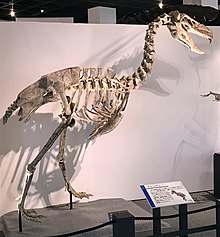| Kelenken Temporal range: Middle Miocene (Colloncuran)~
| |
|---|---|

| |
| Reconstructed skeleton in Fukui Prefectural Dinosaur Museum | |
| Scientific classification | |
| Domain: | Eukaryota |
| Kingdom: | Animalia |
| Phylum: | Chordata |
| Class: | Aves |
| Order: | Cariamiformes |
| Family: | †Phorusrhacidae |
| Subfamily: | †Phorusrhacinae |
| Genus: | †Kelenken Bertelli et al. 2007 |
| Species: | †K. guillermoi
|
| Binomial name | |
| †Kelenken guillermoi Bertelli et al. 2007
| |
Kelenken is a genus of phorusrhacid ("terror bird"), an extinct group of large, predatory birds, which lived in what is now Argentina in the middle Miocene about 15 million years ago. The only known specimen was discovered by high school student Guillermo Aguirre-Zabala in Comallo, in the region of Patagonia, and was made the holotype of the new genus and species Kelenken guillermoi in 2007. The genus name references a spirit in Tehuelche mythology, and the specific name honors the discoverer. The holotype consists of one of the most complete skulls known of a large phorusrhacid, as well as a tarsometatarsus lower leg bone and a phalanx toe bone. The discovery of Kelenken clarified the anatomy of large phorusrhacids, as these were previously much less well known. The closest living relatives of the phorusrhacids are the seriemas. Kelenken was found to belong in the subfamily Phorusrhacinae, along with for example Devincenzia.
Phorusrhacids were large, flightless birds with long hind limbs, narrow pelvises, proportionally small wings, and huge skulls, with a tall, long, sideways compressed hooked beak. Kelenken is the largest-known phorusrhacid, 10% larger than its largest relatives known previously. At 716 mm (2.3 ft) long, the holotype skull is the largest known of any bird, and has been likened to the size of a horse's skull. The tarsometatarsus leg bone is 437 mm (17 in) long. Kelenken is thought to have been about 3 m (9.8 ft) tall and exceeded 100 kg (220 lb) in weight. Kelenken differed from other phorusrhacids in features such as the length of its beak, in having a supraorbital ossification (a rounded edge above the eye socket) that fits into a socket of the postorbital process, and in having an almost triangular foramen magnum (the large opening at the base of the skull through which the spinal cord enters).
Phorusrhacids are thought to have been ground predators or scavengers, and have often been considered apex predators that dominated Cenozoic South America in the absence of placental mammalian predators, though they did co-exist with some large, carnivorous borhyaenid mammals. The long and slender tarsometatarsus of Kelenken suggests that it could run faster than had previously been assumed for large phorusrhacids, and would have been able to chase down small animals. Studies of the related Andalgalornis show that large phorusrhacids had very rigid and stiff skulls; this indicates they may have swallowed small prey whole or targeted larger prey with repetitive strikes with the beak. Kelenken is known from the Collón Curá Formation, and lived during the Colloncuran age of South America, when open environments predominated, which allowed more cursorial (adapted for running) and large animals to occur. The formation has provided fossils of a wide range of mammals, with a few fossils of birds, reptiles, amphibians, and fish.